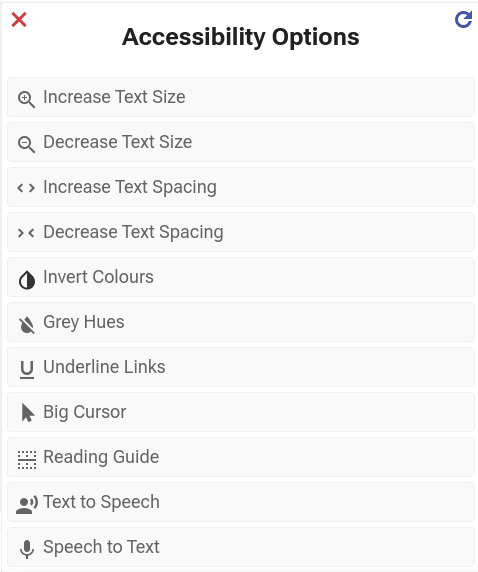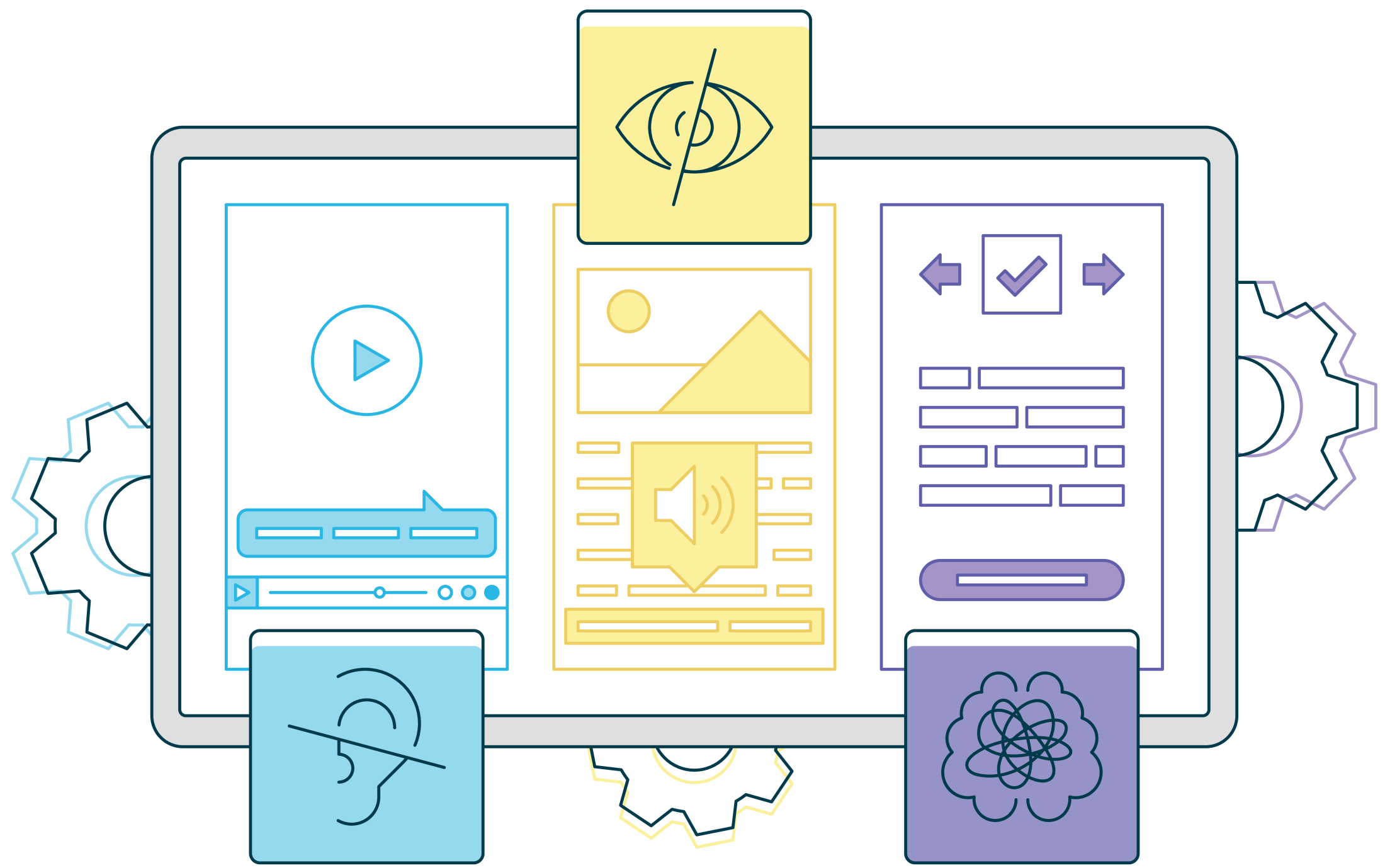Joomla 4 has taken a proactive step towards promoting digital inclusivity with the introduction of an innovative Accessibility Plugin built into the core framework. Designed to make Joomla websites more accessible to all users, including those with disabilities, the new Accessibility Plugin plugin fosters an environment where everyone can navigate, understand, and interact with digital content.
The Joomla 4 Accessibility Plugin is designed to align with the globally recognized Web Content Accessibility Guidelines (WCAG). By adhering to these standards, Joomla websites can now ensure that their content is Perceivable, Operable, Understandable, and Robust - the four key principles of WCAG.
Regardless of a user's physical or cognitive abilities, they can effectively interact with Joomla websites. This includes features like text-to-speech, high contrast modes, keyboard navigation, and other accessibility options, creating an engaging and user-friendly experience for all visitors
Frontend Advantages of Joomla 4 Accessibility Plugin
Improved User Experience (UX)
A primary objective of Joomla 4's new Accessibility Plugin is to enhance the overall user experience (UX). This plugin takes a significant step towards ensuring that all individuals, regardless of their physical or cognitive abilities, can have a seamless and enjoyable experience while navigating a Joomla-powered website.

- Text-to-Speech
One of the standout features is the text-to-speech functionality. This feature enables visually impaired users, or those with reading difficulties, to have the website content read out to them. The text-to-speech function can help users better understand the information on the site without struggling to read small text or decipher complex fonts. Additionally, it's beneficial for users who prefer auditory learning or those who are multitasking and would like to consume the website content while performing other tasks. - High Contrast Modes
The high contrast mode is another crucial feature aimed at improving the UX for visually impaired users. It allows users to switch to a high-contrast version of the website, which enhances the visibility of the text and other elements on the page. This feature is particularly helpful for users with conditions like color blindness or low vision, as it increases readability and reduces eye strain. - Keyboard Navigation
The plugin also supports keyboard navigation, a key feature for users with mobility impairments who may have difficulty using a mouse or touchscreen. With keyboard navigation, users can navigate through the site using keyboard shortcuts. This feature ensures that all functionalities of the website can be accessed using the keyboard alone, providing an equal opportunity for users with mobility impairments to interact with the site fully. - Scalable Text and Images
The Joomla 4 Accessibility Plugin also allows users to scale text and images. This feature enables users to adjust the size of the text and images on the site according to their preference, making the website more readable and easier to navigate for those with visual impairments.
Joomla 4's Accessibility Plugin takes into account the diverse needs of various users, going beyond the basic standards to create an accessible and positive web experience for everyone.
WCAG 2.1 Compliance
The Web Content Accessibility Guidelines (WCAG) are a series of recommendations for making web content more accessible, primarily for people with disabilities. The most recent version, WCAG 2.1, provides more detailed guidelines and a broader scope of accessibility issues than its predecessor, addressing additional challenges faced by individuals with cognitive or mobility impairments, as well as those with low vision.
- Audience Expansion
Around 15% of the world's population experience some form of disability, and compliance with these standards means your website becomes accessible to this significant demographic. A WCAG 2.1 compliant website accommodates diverse users' needs, such as offering text alternatives for non-text content, providing options to pause or stop multimedia, and ensuring all functionality is available from a keyboard. This inclusivity enhances the user experience for all visitors, not just those with disabilities, leading to higher user engagement and potentially increased web traffic and conversions. - Legal Safeguarding
In addition to the ethical and business reasons for offering an accessible website, complying with WCAG 2.1 also offers legal protection. Various jurisdictions, including Canada, have laws in place to ensure digital accessibility, and failure to comply can lead to legal repercussions. In Canada, the Accessibility for Ontarians with Disabilities Act (AODA) mandates that both public and private sector organizations must make their digital content accessible. This includes websites and web content for organizations with more than 50 employees and all public sector organizations. Similarly, at a federal level, the Canadian Human Rights Act and the Accessible Canada Act further reinforce the requirement for digital accessibility.
-
Enhanced Reputation
Compliance with WCAG 2.1 also enhances an organization's reputation. It signals a commitment to digital inclusivity, reflecting positively on the brand. It shows that the organization values all users and is proactive in removing barriers to accessibility. This commitment can strengthen customer loyalty and even attract new users who value inclusivity.
WCAG 2.1 compliance is not merely a box to check off for your website. It's a crucial aspect of responsible web design and development that expands your audience, safeguards your organization legally, and enhances your brand reputation. Joomla 4's Accessibility Plugin, in aligning with these standards, is a valuable tool in promoting digital inclusivity and accessibility.
Backend Advantages of the Joomla 4 Accessibility Plugin
Inclusive Content Creation
One of the standout features of Joomla 4's new Accessibility Plugin is its commitment to inclusive content creation. The plugin goes beyond making the website accessible to users and extends this accessibility to the content creation process as well. This empowers content creators with disabilities, allowing them to fully participate in the content creation and management process.
- Accessible Media Manager
An integral part of content creation involves managing various media types, including images, videos, and audio files. Joomla 4's Accessibility Plugin features an accessible media manager designed with inclusivity in mind. It provides features such as keyboard accessibility, ensuring that every function, from uploading to editing media, can be performed using keyboard commands. This is particularly beneficial for individuals with mobility impairments who may find using a mouse challenging. Additionally, the media manager supports alternative text for images and captions for videos, enabling content creators to include necessary information that makes media content accessible to visually impaired users. - Accessible Content Editor
The content editor is where most of the content creation happens, and Joomla 4's Accessibility Plugin ensures this process is inclusive as well. The editor meets accessibility standards, offering features such as high contrast mode and scalable fonts, making it easier for visually impaired content creators to work comfortably. Moreover, the editor is fully keyboard-accessible, allowing users with mobility impairments to navigate through the different functions and create content without the need for a mouse. Features like these ensure that content creators with varying abilities can comfortably and effectively contribute to the website. - Accessibility Checks
The plugin also features built-in accessibility checks that assess the content for potential accessibility issues before it's published. This feature educates and assists content creators in understanding and adhering to accessibility standards, ensuring the content they produce is accessible to all users.
Joomla 4's new Accessibility Plugin plays a crucial role in fostering an inclusive content creation process. By providing an accessible environment for content creators with disabilities, it ensures a diverse range of voices and experiences can be represented on the platform. This inclusivity ultimately leads to a richer and more engaging user experience for all visitors.
Comprehensive Accessibility Checker
The comprehensive accessibility checker is a critical feature of Joomla 4's new Accessibility Plugin. This tool provides a mechanism to evaluate and validate the accessibility of content before it's published, making it easier to maintain a website that is inclusive and compliant with WCAG 2.1 standards.
- Pre-Publication Accessibility Audit
With the accessibility checker, you can run an accessibility audit on your content before it goes live. This includes reviewing text, images, links, multimedia, and other elements for potential accessibility issues. By catching and correcting these issues before publication, you can ensure that all users, including those with disabilities, can interact with your content as intended. - WCAG 2.1 Compliance
The checker is designed to validate content against the WCAG 2.1 guidelines, the current global standard for web accessibility. It checks for a variety of issues related to these guidelines, such as missing alt text for images, insufficient color contrast, incorrect use of headings, and more. When an issue is detected, the checker alerts the content creator, helping them understand and address the problem. - Educational Resource
The accessibility checker serves not just as a validation tool, but also as an educational resource. When an accessibility issue is found, the checker doesn't just flag it; it also provides information about why it's a problem and how to fix it. This feedback helps content creators gain a deeper understanding of web accessibility, enabling them to create more inclusive content in the future. - Enhanced Quality Assurance
With the accessibility checker, you add an extra layer of quality assurance to your content creation process. By ensuring that your content meets accessibility standards, you can enhance the user experience, expand your audience reach, and protect your organization from potential legal complications related to digital accessibility.
Joomla 4's comprehensive accessibility checker is a powerful tool that makes it easier to create and maintain an accessible website. By integrating accessibility checks into the content creation process, Joomla 4 reinforces its commitment to digital inclusivity and WCAG 2.1 compliance.
Accessibility Plugin Customization
Joomla 4's new Accessibility Plugin offers an impressive degree of customization, providing developers with the flexibility to adapt and configure the accessibility options to best suit their website's specific needs and audience. This ability to tailor the plugin's features enhances the functionality and inclusivity of any Joomla-powered website.
- Adjustable Accessibility Features
The plugin allows developers to enable, disable, or modify specific accessibility features as required. For instance, if a website's primary audience includes a significant number of visually impaired users, developers can emphasize features like text-to-speech, high contrast modes, and scalable text. On the other hand, if the site is primarily used by individuals with mobility impairments, developers can focus on optimizing keyboard navigation. This flexibility ensures the site is tailored to meet the unique needs of its user base. - Customizable User Preferences
The plugin also provides end users with the ability to customize their individual accessibility preferences. For instance, users can choose to enable or disable the high contrast mode, adjust text size, or turn on the text-to-speech function based on their requirements. This ability to personalize the browsing experience makes the website more user-friendly and inclusive, accommodating a wider range of user needs and preferences. - Integration with Other Extensions
Joomla 4's Accessibility Plugin is designed to work seamlessly with other Joomla extensions. This ensures that developers can maintain the accessibility features while adding new functionalities or design elements to the website, offering a consistent and inclusive user experience across all aspects of the site. - Adaptability to Future Needs
Importantly, the plugin's customizability ensures the website can easily adapt to future accessibility needs or changes in regulations. Developers can update settings, add new features, or adjust existing ones as necessary, making the website resilient and future-proof in terms of accessibility.
The new Joomla 4 Accessibility Plugin is a significant step towards digital inclusivity. By ensuring your website is accessible to all users, you can broaden your audience, improve your SEO, and foster a more inclusive online experience.
Website accessibility offers a multitude of advantages. From a user experience perspective, it ensures that a wider audience can interact with your website, improving engagement and potentially leading to a larger user base.




